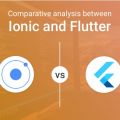Compatible Frontend-Backend Pairings to Consider for App Development Projects!
Would you like to ensure a productive SDLC (software development lifecycle) and deliver an impeccable & performant software end-product? Well, the most important aspect in this regard is picking the right technology stack that best suits your project requirements. Here, picking the aptest front-end & back-end development technologies play a vital role. The front end comprises the presentation layer that is displayed via user screens and is accessible to the end users. The back end refers to the server side that forms the backbone of the application but cannot be accessed or viewed by the end users. For executing most large-scale app/website development projects, you need a sound front-end and back-end combo.
However, today there are numerous technologies, frameworks, programming languages, and tools to choose from. As such, it becomes all the more confusing for entrepreneurs to pick the right tech stack for front-end & back-end development. So, what’s the solution? You need to conduct extensive research, weigh the pros and cons of tech stacks, and match your requirements with all available solutions before you make the final decision.
This post explores the popular front-end backend framework combinations along with their distinct offerings. A quick read will guide you through the decision-making process.
1. React & Node.js (Express)
React
React is a Facebook-developed, open-source, and JavaScript-based framework. It has gained popularity as a front-end web development framework. Its key features include component-based architecture, one-way data binding, Virtual DOM, declarative user interface, and JSX.
React app development services have been leveraged by several leading brands such as Facebook, Instagram, WhatsApp, Netflix, Airbnb, Uber, etc. to create success stories.
Node.js (Express)
Node.js is an open-source Google Chrome-based JS framework created on the V8 engine of JavaScript. Its architecture is single-threaded and event-driven enabling asynchronous non-blocking operations. Here, lesser resources are used as several threads do not have to be created. Despite being single-threaded, Node.js can handle humongous data. Furthermore, the runtime environment of this framework is utilized for developing customized back-ends of applications.
React & Node.js Pairing: Advantages
Now, let’s explore the offerings of React and Node.js as a noteworthy front-end backend combination. This pairing is highly recommended for web app development.
JavaScript Usage for Front-end & Back-end
The React & Node.js duo facilitates using JavaScript for front-end as well as back-end development as both frameworks support JavaScript. And, JavaScript comes with an easy learning curve. This leads to the creation of universal isomorphic applications that run the JavaScript code for both the front-end and backend. In isomorphic apps, the app’s server-side and client-side can communicate with each other more efficiently and speedily.
Also, this combo doesn’t need to use complicated back-end programming languages like Ruby or Python. As such, app developers enjoy the flexibility to build amazing web apps and websites effortlessly.
Coding Advantages
React developers can run the code directly in the Node.js environment as both frameworks are JS-based. Moreover, the React DOM contains components that are highly compatible with Node.js. This results in fewer lines of code and simplifies the process of server-side rendering.
React’s Dependency on Node.js Modules & Utilities
Node.js provides modules that can be used for consolidating the React app into a single file. Another utility feature is the npm (Node Package Manager), a marketplace providing open-source JS tools that one can access easily. npm helps React to identify the native side (Android/iOS) of the packages used in an app so that the necessary dependencies can be added.
JSON API Creation
Node.js’s high code reusability and React’s capability of instant code sharing prove beneficial in creating JSON APIs for web apps. Also, it is easy to integrate JSON files with Node.js; this way users can gain access to the necessary information easily.
Single Page Application (SPA) Development
The React & Express duo is a great pick for developing SEO-friendly single-page applications or SPAs. This pair forms a robust &lightweight backend model that enables smooth & asynchronous data loading via callback functions.
Boosts Scalability & Performance
The Node.js and React.js combo is known for creating modular, data-driven, responsive, dynamic, and scalable web applications. This is because the modular architecture of both of these frameworks speeds up the response time as well as the page load time. Node.js leverages the speed of the V8 engine for handling bulk requests using callback functions. React’s virtual DOM boosts app performance. So, this pair is ideal for building scalable and performant web apps and brings a lot to the table if your website or app is expected to grow with time.
Handles high Server Load
React has been designed to handle heavy internet traffic and together with Node.js, it can cater to multiple requests at a time. Consequently, the apps developed in React and Node.js are capable of handling humongous traffic and managing high server loads and multiple requests simultaneously. Hence, the chances of app crashes are minimal.
MERN Stack Compatibility
MERN Stack is a technology stack that offers a unique dimension to web apps and websites. This stack comprises a combination of React, Express.js, Node.js, and MongoDB. Therefore, the React & Node.js pair is an excellent choice for MERN Stack development.
Saves time and efforts
Node.js & React come with goodies like high code reusability and cross-platform compatibility. Therefore, it becomes easy to create and maintain apps and reduces the time-to-market considerably.
2. React Native & Django
React Native and Django is a popular combo for front-end & back-end development. Take a look at their USPs.
React Native
React Native is an open-source JS-based framework that has been designed by Facebook for developing cross-platform mobile apps. React Native developers need to code once and reuse it across iOS and Android operating systems instead of coding independently for separate platforms. Today, RN support has been extended to desktop and web apps as well. The framework has React.js as its base and enables developers to craft robust apps speedily using their JavaScript skills.
React Native has been utilized by renowned brands like Facebook, Skype, Pinterest, Instagram, Tesla, Bloomberg, Discord, Walmart, etc.
Django
Django, an open-source Python-based high-end framework, is a popular pick for back-end development. This framework is ideal for mid-sized to large-scale apps with a rich feature set.
Django is preferred by businesses due to advantages like easy-going structure, reliability, scalability, etc. Brands such as Spotify, YouTube, Disqus, Instagram, etc. have leveraged Django. It comes with model-template-view architecture. It follows the DRY (Don’t Repeat Yourself) approach that speeds up the software development lifecycle. Django employs ORM (Object Relational Mapper) for making CRUD operation calls to the database; it enables developers to design complex functionalities easily. With this dynamic CRUD (Create, Read, Update, & Delete) interface, managing huge data-driven websites becomes much easier. Besides, the presence of Python makes it easy for developers to implement ML algorithms into apps.
React Native & Django Pairing: Advantages
Applications developed in React Native & Django are secure & speedy and involve a cost-effective development process. This pair caters to the app development requirements of all kinds of enterprises - right from small-scale to large-scale ones – and can deal with different amounts of traffic and varying objectives.
This duo is a viable choice if your software development requirements involve cross-platform compatibility. Let’s take the example of web apps that are meant to function across different platforms. Such apps, if developed in React Native & Django, require the least amount of coding, unlike other frameworks.
Django supports plugins of several other frameworks. Hence, the Django-React Native combination works well for app development projects that involve multiple frameworks.
3. Angular & Node.js (Express)
Check out the offerings of the Angular-Node.js combo for front-end & back-end development.
Angular
Angular is a Google-created open-source framework used to develop apps for mobile and desktop. Angular app development services can be used to build performant & responsive apps. Angular is also a good choice for crafting SPAs (single-page applications).
The framework is based on TypeScript and this feature helps developers effortlessly identify bugs while writing the code. As such, writing high-quality code and maintaining the code becomes easier; more so if you are coding a large-scale app in JavaScript.
Angular & Node.js Pairing: Advantages
Angular when combined with Node.js, brings a lot to the table. Both are TypeScript-based frameworks. With Node.js, developers can host an app locally by setting up a simple webserver. With the Angular CLI (Command Line Interface), it becomes easy to handle complex development tasks like the bundling of CSS & JavaScript files and the HTML doc during web hosting.
Node’s “npm,” supports Angular’s CLI; so you need not write the boilerplate manually. Furthermore, Angular CLI employs Webpack for bundling the app. This approach helps to hide the complexities likely during app bundling and this way proves helpful for newbie Angular developers.
4. Vue & Laravel
Here’s another popular pair for front-end & back-end development – Vue & Laravel.
Vue
Vue is an open-source JS framework that is used for creating the view layer of a web-based app, particularly in a single-page application. This is a progressive front-end framework and is based on MVVM architecture. Thanks to its virtual DOM, Vue is speedy and requires minimal resources. It involves an easy learning curve; developers well-versed in JavaScript & HTML can effortlessly master Vue. Vue’s two-way data binding approach allows you to maintain the consistency of your data across the front end and back end. Moreover, the framework can effortlessly integrate with various libraries and frameworks.
Laravel
Laravel, an open-source PHP-based framework, is a preferred pick for web app development. It is one of the most loved back-end frameworks and comes with a host of in-built features and handy development tools. Thanks to Laravel’s MVC architecture, you can develop large-scale feature-rich apps that are easy-going, scalable, and flexible. It has an ORM called Eloquent that enables developers to interact with objects instead of SQL. Laravel offers the Artisan command line that produces handy commands to help with functions like boilerplate code generation and cache clearance. The other offerings of Laravel include automatic package delivery, the Blade Template Engine, advanced routing, robust security, and seamless Database migration capabilities.
Vue & Laravel Pairing: Advantages
The Vue-Laravel pair is one of the best picks for creating reactive event-driven apps due to Vue’s single-file component approach and Laravel’s event-driven architecture. Such apps are more responsive and do not require continuous data polling. This duo is suitable for SPA development as well. Here, Laravel simplifies handling the authorization and authentication of SPAs while Vue facilitates creating a rich UI.
Laravel is known for its powerful built-in security features that ensure the security of an app. Vue strengthens app security by offering a templating system that can prevent XSS (cross-site scripting attacks).
Using this combo, developers can build web apps very fast without the need for specific database expertise as both of these frameworks make it easy for you to work with databases from inside the code. Also, you can keep your database clean and organized without having to write a lot many new codes. Furthermore, Laravel’s Schema Builder or Laravel Migrations make database migration a breeze. Modifications can be made without having to write much SQL manually. With Vue and Laravel, serverless deployment becomes easier and more cost-effective.
Final Thoughts:
I hope the aforementioned information will help you to pick the right pair of front-end & back-end development frameworks that perfectly aligns with your project requirements. You must keep in mind that every project is different from the others and comes with its unique set of requirements. Therefore, if your project involves developmental complexities, high-level features, etc.; seek professional advice & assistance from an experienced software development firm.
Other articles and publications:
Articles and publications of other companies:
- +1 (469) 277-0804
- 8305 Tripoli Trl, Frisco, TX 75034, United States
- www.biz4solutions.com/













